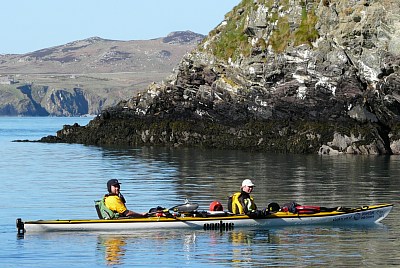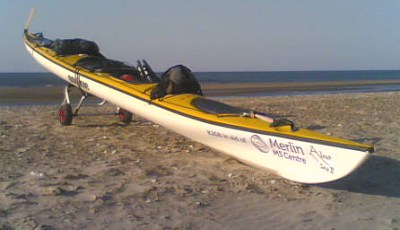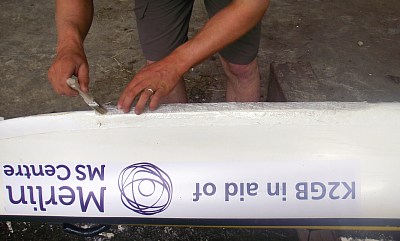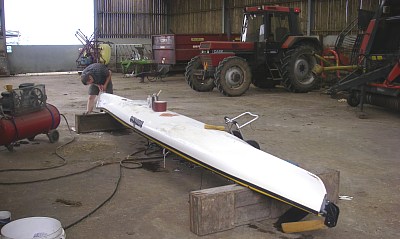Post-expedition Equipment Review
December 2013
Our boat Persey – Valley Aleut Sea II

|

|
Because of the weight of the Aleut we had to take care when landing, choosing landing spots carefully and sometimes even exiting the boat just before she came to shore to relieve her of our own weight and avoid causing damage to the hull on less ideal landings.
 26 July. Fibre-glass repairs to the damaged and leaking hull. |
 26 July. The barn at Bottom House Farm doubling as a boatyard. |
Andy had to make 3 separate fibreglass repairs to the hull over the course of the trip in two different areas. The weak spots were up near the bow where she would run ashore and at the rigid centre beneath the central bulkhead. Because the hull cannot flex due to the bulkhead up against the hull there was no give and so it also took the brunt during landings and launches. We bought and fitted an Easykeel keel strip before departing but unfortunately this came off in places within a matter of weeks, causing drag and then obviously not protecting the hull as designed to do. We would probably not use this type of keel strip again.
As said, we made the decision to use our trusted old double and do not regret doing so. The space it allows for kit is brilliant and better than any other double kayak we’ve seen on the market. The speed is also pretty good but most of all, it is just such a stable boat in rough conditions. We never felt insecure or twitchy in the Aleut at any point during the trip, whether through big tide races or a big following sea, broadside to the wind or indeed into it. She was always plenty stable to fish from, eat from and even allowed stability for Jane’s Shewee manoeuvres!
Paddles
Having imagined we would regularly swap paddles depending on conditions on the sea we were both surprised to find that we much preferred to use the winged blades. (See equipment list) The wings were used every day and we felt comfortable even in rough conditions. It actually became difficult to paddle with the flat paddles in the end because we were so used to the wing technique. The others just felt so heavy in comparison but we wouldn’t dream of not having a spare set. We probably should have used the flats in the bigger tide races in case of the need to roll as it is a lot easier to roll with the flat blades.
Ditched kit
It didn’t take us long to start ditching some of our kit which we realised was either doubled up or unnecessary on this particular trip. We also quickly realised how much weight we were carrying and felt that less was actually safer in terms of minimising the risk of injury to ourselves when carrying kit and boat. The following items we would not bother to take again next time:
- Pillow cases (didn’t use, just put other clothes inside a soft fleece)
- Sheet over thermorests (just slept inside the duvet cover itself and washed that as often as possible)
- Heavy duty boat lock, with padlock (too heavy, only used twice, nicer just to trust people – easier to do with a double though as people unlikely to be able to ‘walk off’ with it as easily as a single kayak)
- Throw bag (used slings at each end of the boats instead, which assisted carrying the boat and spreading the load across the body. Throw bag bulky and very when wet. We mostly paddled alone, so less likely to need it in safety situation)
- Clothes – we both found we had too many clothes with us despite thinking we’d been strict with ourselves. On land we just used one pair well-made warm shore trousers (Rab / Montane) and one pair lightweight & very quick drying shorts, two sets of thermals, two fleeces and a good set of waterproofs. It was mainly surplus paddling clothes we got rid of.
- Footwear - I (Jane) ditched my wellies and sandles early on – I found them uncomfortable and hard to keep dry as well as bulky to store. I wore crocs throughout the trip (in the boat and on shore). I went through one pair by the time we got to Thurso – although they were already 2 years old! Easy to replace and cheap. Did not smell, dry instantly and let your feet breathe. Andy went to the other extreme and bought an additional pair of wellies! He kept one dry in the hatch for on shore and wore the others for paddling, finding them warm and comfortable. He also had sandles which were worn a lot more towards the end.
- Fold-up chairs – again, great on shorter trips but too much bulk for this one and had issues trying to store them and keep them dry. You can usually find a rock to lean against instead.
- Additional gas stove for frying - Once Andy discovered a brilliant method of cooking over the Storm Kettle we hardly had need for the extra stove. We used a trangia with gas attachment when wet, but whenever dry twigs were available on the shore, we boiled all water and cooked all meals using the Storm Kettle and trangia surround over the base.
Items we should have taken!
- A spare tent pole – sometimes difficult to make a good temp repair and can be hard to order new ones quickly while on this sort of trip.
- More batteries for the GoPro
- An additional drybag for the down duvet
- A larger tent – It was okay with our tiny expedition tent (Macpac minaret) in dry conditions but there is barely any porch space, two cannot sit up inside at once and if it rains, everthing needs storing in drybags outside the tent. At times we were nervous about the security of the kit we had to leave outside. Although nothing was ever taken, we were a little uncomfortable with this system as our kit was so important to us. (We always stored paddles between the tent outer and inner out of view at night.) The Minaret is a fantastic little tent and great for shorter trips with the tarpaulin pitched above it to extend your living space considerably but when we had stormy weather we could certainly have done with more sheltered living space.
Items we had to replace or mend during the trip:
- Palm Roanoke spraydecks – these were just not up to the trip. They were not waterproof, the material degraded quickly and the zip pockets let in and held in water, making the deck heavy and sag from the waist. We replaced these with Reed Chillcheater decks which proved to be totally watertight, comfortable, an excellent fit around the deck and are still in good condition now.
- Jane’s crocs – fair enough, they were used day in-day out and were far from new to begin with. Not even real crocs! Easy & cheap to replace.
- Tent pole – pretty early on one of the poles snapped. We managed to repair it but it was always a worry that it would snap again and a spare pole would have been reassuring to have. The poles lost their coating and got extremely stiff at the joins and we had to rub Vaseline on them almost daily in the latter half of the expedition.
- The first solar panel – it lasted about 1 month but then we had to replace it. The new one was sent to a post office for collection at Lochaline on the Sound of Mull. This one packed up after about a week but on getting in touch with the company they immediately sent a new one free of charge having added extra sealant to ensure its waterproofing and this one lasted well. The panel was marine grade.
- The tarp – a goat got it caught in its horns while we were out of camp getting provisions on a wind bound day - we’ll never know whether this was intentional or not!! Andy managed to stitch it up but we ordered a new one in case it was no longer waterproof.
Kit – Top 15 items!
- Winged paddles - Epic midwings Ulitimate kayaks
Contact: (See sponsors page for link) - Jane’s drysuit – Nookie paddling equipment
Contact: (See sponsors page for link) - Sealskinz thermal waterproof hats with ear flaps for added warmth. And the socks – even when a bit damp after several months of wear, dry really quickly outside. Warm.
Contact: Sealskinz (See sponsors page for link) - Storm kettle - burns twigs to heat water and save on gas – reckon we only used about 4 medium gas canisters over the 5 months, all thanks to the storm kettle. We also cooked on it and could use the hot ash to help start our camp fires too.
Contact: Storm kettle / Kelly Kettle - Reed spraydecks and short sleeved cag Reed chillcheater
Contact: (See sponsors page for link) - Axelpack waterproof map cases – totally watertight and 100% better than what we were initially using which was hopeless!
Contact: Cackle TV website (See sponsors page for link) - Pogies gloves (Palm) Used daily for the first 2-3 months of the trip. Jane had the warmer ones, Andy had the more basic ones – both really pleased with them.
Contact: Palm paddling equipment - Shewee – Absolutely invaluable. Don’t know what I’d have done without it! (JANE!) Learnt how to use it in the boat and also good for landing and not having to get out of drysuit to go to the loo.
Contact: Shewee / Outdoor stores, such as Cotswolds - Reeds small craft Almanac – our reference bible for tides and currents
- Solar panel – for charging phones, VHF radio, camera and video camera batteries
Contact: Marine grade Bought fittings sep. from chandlers - Kayak trolley – saved our backs, can carry partially loaded double kayak
Contact: Available at various places online - Tarpaulin 4x4m – excellent quality
Contact: Robens - Good camera equipment to record your adventure Pentax optios, Sony waterproof video camera
- SPOT Satellite GPS Messenger – for keeping the trips live for viewers + safety on long crossings
Contact: Global Telesat Communications (See sponsors page for link) - Hand line – simple, small, effective, hand-made round spool (wooden) Perfect for Mackerel, Pollack and Bass.
Contact: Ask Andy!! (£25 with tackle & line)
Food & fuel
- The food box as described on the main equipment page worked well. It did involve a lot of tubs but seemed to keep things more hygienic and organised. The BDH containers with rice & GORP were also perfect. The BDH took 1kg rice. Each day we decanted GORP (fruit & nuts mix) into smaller tubs kept in our deckbags for eating during the day on the water.
- Dehydrated meals – home-cooked and dehydrated prior to the trip and sent to us as packages en route by family to strategic points. These were space and weight-saving, easy to cook up (just simmer for 20mins while getting camp set up ..... and they were really tasty. (We have our own dehydrator at home for preparing these meals, bought online for about £150 several years ago. Well worth it if you do a lot of tripping for more than a few days at a time.)
- We found that we craved fresh food and ate it as often as possible. This was very often stored on deck due to its bulky, easy-bruising nature and kept it accessible. Very refreshing and healthy.
- We always carried a knife on our person on the sea for safety and for peeling fruit, making up wraps for lunch etc.
- 75% of cooking was done on the base of the storm kettle with trangia outer to place the pan on/in. This was a self-discovered method and meant we used ‘free fuel’ (twigs) and felt like real camping. While we always carried gas, we didn’t ever carry more than 2 canisters aboard.
- Nearly all water was boiled in the storm kettle for hot drinks, washing, washing-up, meals to save on gas.
- We had an Ortlieb collapsible washing-up bowl used for washing up as well as washing ourselves and collecting stream water. Packs down small and really useful.
- Ortlieb and MSR water bags, varying sizes from 2lt-8lt.
^Top of Page^